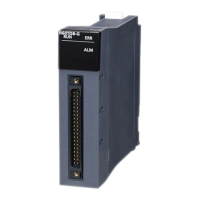646
7 APPLICATION INSTRUCTIONS
7.8 String Processing Instructions
Converting 32-bit binary data to decimal ASCII
DBINDA(P)(_U)
These instructions convert 32-bit binary data to the decimal ASCII code.
■Execution condition
■Descriptions, ranges, and data types
■Applicable devices
Ladder ST
ENO:=DBINDA(EN,s,d);
ENO:=DBINDAP(EN,s,d);
ENO:=DBINDA_U(EN,s,d);
ENO:=DBINDAP_U(EN,s,d);
FBD/LD
Instruction Execution condition
DBINDA
DBINDA_U
DBINDAP
DBINDAP_U
Operand Description Range Data type Data type (label)
(s) DBINDA(P) Binary data used for ASCII conversion -2147483648 to 2147483647 32-bit signed binary ANY32_S
DBINDA(P)_U 0 to 4294967295 32-bit unsigned binary ANY32_U
(d) Start device for storing the conversion result String ANYSTRING_SINGL
E
EN Execution condition Bit BOOL
ENO Execution result Bit BOOL
Operand Bit Word Double word Indirect
specification
Constant Others
X, Y, M, L,
SM, F, B, SB,
FX, FY
J\ T, ST, C, D, W,
SD, SW, FD, R,
ZR, RD
U\G, J\,
U3E\(H)G
Z LT, LST,
LC
LZ K, H E $
(s)
(d)
RnCPU
RnENCPU
RnSFCPU RnSFCPURnPCPURnPCPU
(Standard) (Safety)
(Redundant)
(Process)

